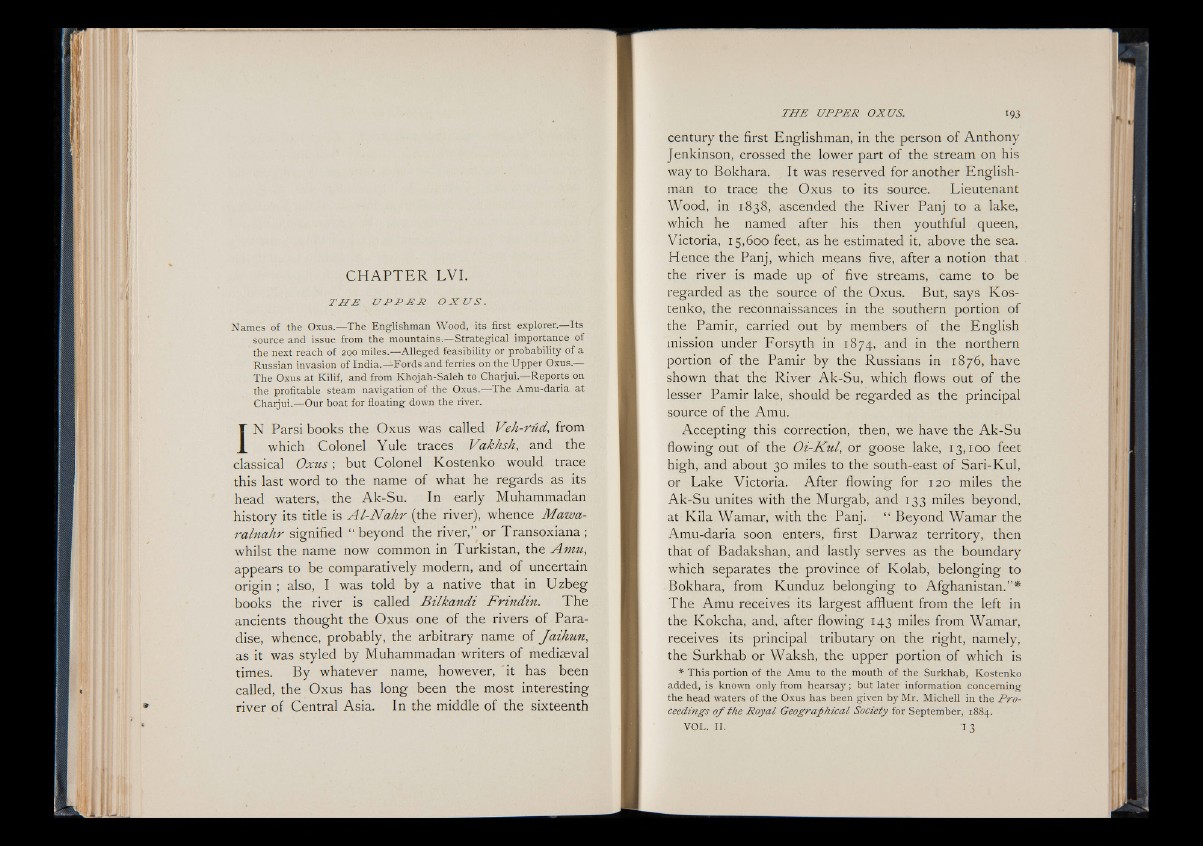
C H A P T E R LV I.
T H E U P P E R O X U S .
Names of the Oxus.— The Englishman Wood, its first explorer.— Its
source and issue from the mountains >—Strategical importance of
the next reach of 200 miles.—Alleged feasibility or probability of a
Russian invasion of India.—Fords and ferries on the Upper Oxus.— .
The Oxus at Kilif, and from Khojah-Saleh to Chaijui.— Reports on
the profitable steam navigation of the Oxus,—The Amu-daria at
Chaijui.—Our boat for floating down the river.
IN Parsi books the Oxus was called Veh-rud, from
which Colonel Yule traces Vakhsh, and the
classical O x u s; but Colonel Kostenko would trace
this last word to the name of what he regards as its
head waters, the Ak-Su. In early Muhammadan
history its title is A l-N a h r (the river), whence Mawa-
ralnahr signified “ beyond the river,” or Transoxiana ;
whilst the name now common in Turkistan, the Amu,
appears to be comparatively modern, and of uncertain
origin ; also, I was told by a native that in Uzbeg
books the river is called B ilkan di Frindin. The
ancients thought the Oxus one of the rivers of Paradise,
whence, probably, the arbitrary name of Jaihun,
as it was styled by Muhammadan writers of mediaeval
times. By whatever name, however, 'it has been
called, the Oxus has long been the most interesting
river of Central Asia. In the middle of the sixteenth
century the first Englishman, in the person of Anthony
Jenkinson, crossed the lower part of the stream on his
way to Bokhara. It was reserved for another Englishman
to trace the Oxus to its source. Lieutenant
Wood, in 1838, ascended the River Panj to a lake,
which he named after his then youthful queen,
Victoria, 15,600 feet, as he estimated it, above the sea.
Hence the Panj, which means five, after a notion that
the river is made up of five streams, came to be
regarded as the source of the Oxus. But, says Kostenko,
the reconnaissances in the southern portion of
the Pamir, carried out by members of the English
mission under Forsyth in 1874, and in the northern
portion of the Pamir by the Russians in 1876, have
shown that thé River Ak-Su, which flows out of the
lesser Pamir lake, should be regarded as the principal
source of the Amu.
Accepting this correction, then, we have the Ak-Su
flowing out of the O i-K ul, or goose lake, 13,100 feet
high, and about 30 miles to the south-east of Sari-Kul,
or Lake Victoria. After flowing for 120 miles the
Ak-Su unites with the Murgab, and 133 miles beyond,
at Kila Wamar, with the Panj. “ Beyond Wamar the
Amu-daria soon enters, first Darwaz territory, then
that of Badakshan, and lastly serves as the boundary
which separates the province of Kolab, belonging to
Bokhara, from Kunduz belonging to Afghanistan.”*
The Amu receives its largest affluent from the left in
the Kokcha, and, after flowing 143 miles from Wamar,
receives its principal tributary on the right, namely,
the Surkhab or Waksh, the upper portion of which is
* This portion of the Amu to the mouth of the Surkhab, Kostenko
added, is known only from hearsay ; but later information concerning
the head waters of the Oxus has been given by Mr. Michell in the Proceedings
o f the Royal Geographical Society for September, 1884.